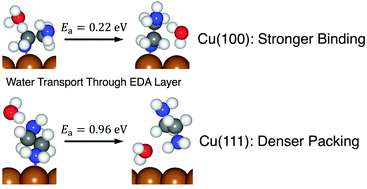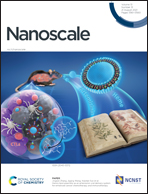Adsorption of ethylenediamine on Cu surfaces: attributes of a successful capping molecule using first-principles calculations†
Abstract
The shape-controlled synthesis of Cu nanocrystals can benefit a wide range of applications, though challenges exist in achieving high and selective yields to a particular shape. Capping agents play a pivotal role in controlling shape, but their exact role remains ambiguous. In this study, the adsorption of ethylenediamine (EDA) on Cu(100) and Cu(111) was investigated with quantum density functional theory (DFT) to reveal the complex roles of EDA in promoting penta-twinned Cu nanowire growth. We find EDA has stronger binding on Cu(100) than on Cu(111), which agrees the general expectation that penta-twinned Cu nanowires express facets with stronger capping-molecule binding. Despite this stronger binding, ab initio thermodynamics reveals the surface energy of EDA-covered Cu(111) is lower than that EDA-covered Cu(100) at all solution-phase EDA chemical potentials, so there is no thermodynamic driving force for penta-twinned nanowires. We also investigated the capability of EDA to protect Cu surfaces from oxidation in water by quantifying energy barriers for a water molecule to diffuse through EDA layers on Cu(100) and Cu(111). The energy barrier on Cu(100) is significantly lower, which supports observations of faster oxidation of Cu(100) in electrochemical experiments. Thus, we elucidate another possible function of a capping agent – to enable selective oxidation of crystal facets. This finding adds to the general understanding of successful attributes of capping agents for shape-selective nanocrystal growth.



 Please wait while we load your content...
Please wait while we load your content...